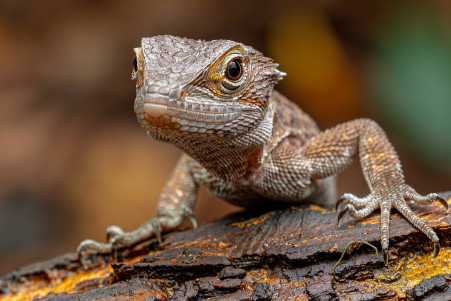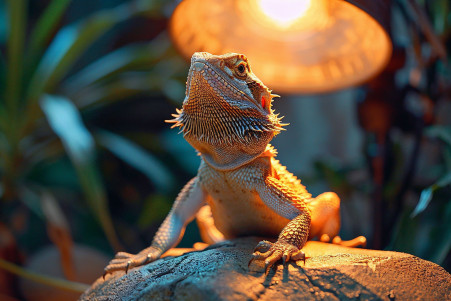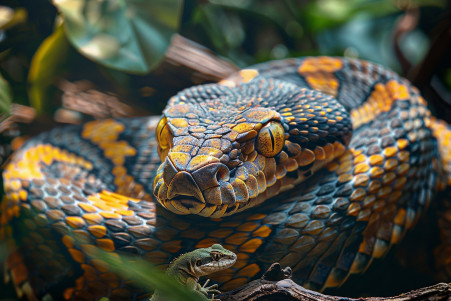Do Lizards Have Poison? The Science of Lizard Toxins
10 May 2024 • Updated 9 May 2024

Lizards are some of the most fascinating creatures on the planet, with their scales and unique ways of moving, but are any of them poisonous? While no lizards have toxins that are poisonous if ingested, some lizards, such as the Gila monster and beaded lizards, have venom glands that allow them to deliver a venomous bite. That said, the venom they produce is weak and not generally dangerous to humans.
Even though a few lizards have evolved to have venom, most lizards have other ways of defending themselves, such as blending into their surroundings, running away, or threatening other animals. To help you better understand which lizards are and aren't poisonous, we'll look at studies from the fields of herpetology, evolutionary biology, and toxicology. This will help you learn about the different ways lizards deliver venom, the composition and effects of their venom, and how these adaptations have evolved to help lizards survive in a variety of habitats. By the end, you'll know which lizards are the most dangerous and which ones, while they may look scary, are the least likely to harm you.
Do Lizards Have Poison?
Helodermatidae: Gila Monsters and Beaded Lizards
The venomous lizard family is made up of only five species - the Gila monster (Heloderma suspectum) from the deserts of the southwestern United States and northwestern Mexico, and four species of beaded lizards from Mexico and Guatemala. These heavy-bodied lizards have large heads, strong jaws, and a slow, plodding gait. They can also perform a threatening defensive display by opening their mouths wide and hissing when they feel threatened.
Unlike venomous snakes, which produce venom in glands located behind their eyes, the Gila monster and beaded lizards produce venom in modified salivary glands in their lower jaws. Their teeth are grooved to help deliver the venom when they bite and chew. The venom is a cocktail of toxins including hyaluronidase, serotonin, and kallikrein-like glycoproteins that cause severe pain, swelling, and a sudden drop in blood pressure, according to a study cited on Wikipedia.
Although the bite is excruciating, it is seldom fatal to humans unless the person has an allergy or an underlying medical condition. There have been very few deaths, as these lizards are not aggressive and are rarely encountered by people in their remote desert homes. Nevertheless, their venomous nature means that they must be treated with respect and handled responsibly.
Other Risks and Hazards of Non-Venomous Lizard Bites
While venomous lizards like the Gila monster and beaded lizard are dangerous, non-venomous lizards can also pose risks through their bites. According to PeaceHealth, the force of a lizard's jaws can cause "crushing, or compression, injury" that leads to severe swelling and tissue damage. Bites can also result in teeth being left behind in the wound, which can increase the likelihood of infection.
In addition to bites, all lizards can spread Salmonella through their feces, as well as through scratches and bites, according to Critter Control. Even if a lizard species isn't venomous, CHOC Children's advises that emergency medical care should be sought for any lizard bite because it can be difficult to determine the species and non-venomous bites can still result in serious complications.
To reduce the likelihood of lizard bites, it's important to know how to recognize signs of aggression or defensiveness and to avoid doing things that may provoke these behaviors. With proper care and responsible interaction, the risks associated with non-venomous lizards can be minimized.
How to Handle Lizards: Tips and Safety Measures
Proper handling of lizards is important for the safety of both the handler and the animal. According to The Bio Dude, it’s important to make sure that you are in an escape-proof environment and that you are supporting the lizard so that it can’t flail and hurt itself. It’s also important to know the animal’s personality and stress behaviors, such as hissing or tail whipping, so that you can tell when it’s the right time to handle them.
The RSPCA Knowledgebase recommends that you support the lizard’s spine and legs when you pick them up, rather than just grabbing them, to avoid them trying to escape and potentially injuring themselves. Techniques like “being the rock or tree,” which involves supporting the lizard on your hand or arm, can help the lizard feel more secure. However, it’s important to make sure that you don’t restrain the lizard too much, as this can cause them to become more defensive.
If you are handling more aggressive lizards, such as monitors, it’s important to have specialized training and protocols in place, as mentioned by The Bio Dude. In addition, using the right tools, such as snake hooks, can make handling lizards safer. By following these safety measures, handlers can reduce the likelihood of injury and ensure that both they and the lizard are safe during handling.
How to Treat Lizard Bites: First Aid and Medical Treatment
If you or someone you know has been bitten by a lizard, the first thing you need to do is get the lizard off of the person as quickly as possible. Medscape explains that if the lizard is still attached, it should be removed carefully to avoid breaking off any teeth that may be left in the wound. The lizard can be detached by briefly holding a flame under its chin or submerging it in cold water, but be careful not to get bitten again in the process.
Once the bite is visible, the wound should be cleaned with soap and water. CommonSpirit Health says that a dressing should be applied to control any bleeding and the affected limb should be splinted to prevent movement. The limb should also be kept elevated to the level of the heart while the person is being taken to get medical help.
Although there are no antivenoms for lizard bites, Healthgrades explains that doctors may still need to assess the bite, clean it, and potentially prescribe antibiotics if the bite becomes infected. It can also be helpful to the medical team if you can tell them what kind of lizard bit you.
It's important to get medical help as soon as possible, especially if you've been bitten by a venomous lizard or a large, non-venomous lizard. Be sure to tell the medical team when the bite occurred, where it occurred, and if you've experienced any symptoms. This information will help them know how to best treat you. With the right first aid and medical treatment, the dangers of a lizard bite can be minimized.
Lizards in the Ecosystem and Conservation
Lizards are important members of the ecosystems they live in, acting as both predators and prey. As Backyard Buddies explains, skinks and other lizards help keep insect populations in check by eating pests such as crickets, grasshoppers, and beetles. This can help reduce the need for chemical pesticides. Lizards also help aerate the soil by burrowing and moving around, which can help with drainage and nutrient flow.
In addition to their ecological roles, lizards can also serve as an important sign of environmental quality. As Gardening Know How points out, the presence of common garden lizards can indicate that there are low levels of pollutants and heavy metals, which can ensure that the produce grown in a garden is safe.
Unfortunately, many species of lizards are threatened by habitat loss, pollution, and the pet trade. The Department of Conservation notes that it's important to create lizard-friendly habitats that include hiding places, water, and native plants. It's also important to make sure that people are observing and handling lizards in ways that don't disrupt them and that support conservation. By doing this, we can help ensure that these special reptiles are conserved and that the ecosystems we share with them are preserved.
Conclusion: Understanding and Appreciating Lizards
The truth about lizards is that while a few species possess venom capabilities, their bites are rarely life-threatening to humans. In fact, most lizards pose little risk when encountered or handled properly. These remarkable reptiles play vital roles in their ecosystems, serving as both predators and prey, and their presence can even indicate environmental health.
Lizards have many amazing adaptations, from the ability to change color to the adhesive properties of gecko feet that have inspired new technologies. Even the largest lizard species, like the Komodo dragon, are generally not a threat to humans unless provoked. In some cases, lizard venom is even being studied for potential medical applications.
By understanding and appreciating the unique qualities of lizards, we can learn to coexist with these fascinating creatures. Creating lizard-friendly habitats and supporting conservation efforts are important steps we can all take to protect these reptiles and maintain the delicate balance of our shared ecosystems. With proper precautions and respect, we can safely observe and admire the diverse wonders of the lizard world.


